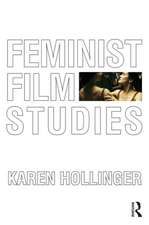Color and the Moving Image: History, Theory, Aesthetics, Archive
Editat de Simon Brown, Sarah Street, Liz Watkinsen Limba Engleză Paperback – 19 noi 2012
| Toate formatele și edițiile | Preț | Express |
|---|---|---|
| Paperback (1) | 440.27 lei 6-8 săpt. | |
| Taylor & Francis – 19 noi 2012 | 440.27 lei 6-8 săpt. | |
| Hardback (1) | 1058.43 lei 6-8 săpt. | |
| Taylor & Francis – 19 noi 2012 | 1058.43 lei 6-8 săpt. |
Preț: 440.27 lei
Nou
Puncte Express: 660
Preț estimativ în valută:
84.24€ • 87.96$ • 69.72£
84.24€ • 87.96$ • 69.72£
Carte tipărită la comandă
Livrare economică 05-19 aprilie
Preluare comenzi: 021 569.72.76
Specificații
ISBN-13: 9780415892643
ISBN-10: 0415892643
Pagini: 286
Ilustrații: 13 black & white halftones, 32 colour illustrations, 1 black & white line drawings
Dimensiuni: 152 x 229 x 15 mm
Greutate: 0.4 kg
Ediția:New.
Editura: Taylor & Francis
Colecția Routledge
Locul publicării:Oxford, United Kingdom
ISBN-10: 0415892643
Pagini: 286
Ilustrații: 13 black & white halftones, 32 colour illustrations, 1 black & white line drawings
Dimensiuni: 152 x 229 x 15 mm
Greutate: 0.4 kg
Ediția:New.
Editura: Taylor & Francis
Colecția Routledge
Locul publicării:Oxford, United Kingdom
Public țintă
Postgraduate and UndergraduateCuprins
Introduction: Simon Brown, Sarah Street, Liz Watkins I. HISTORY. Chapter 1. Simon Brown, "The Brighton School and the Quest for Natural Color" – Redux. Chapter 2. Hilde D’haeyere, Out of the Blue: Color Inserts in Mack Sennett’s Comedy Shorts of the Late Twenties. Chapter 3. Charles O’Brien, Technicolor Song Sequences: Music and Color in King of Jazz (1930). Chapter 4. Anna Batistová, Glorious Agfacolor, Breathtaking Totalvision and…Changing Color Process in Czechoslovak Cinema at the Beginning of the "Scope" Boom. Chapter 5. Sarah Street, Glorious Adventures with Prizma. Chapter 6. Andrew Robert Johnston, The Color of Prometheus: Thomas Wilfred's Lumia and the Projection of Transcendence. II. THEORY. Chapter 7. Tom Gunning, Where Do Colors Go at Night? Chapter 8. Rosalind Galt, "Brash…Indecent…Libertine": Aesthetics and Film Theory Versus Derek Jarman’s Queer Colors. Chapter 9. Jocelyn Szczepaniak-Gillece, The Hues of Memory, the Shades of Experience: The Color of Time in Syndromes and a Century. Chapter 10. Philipp Schmerheim, From Psycho to Pleasantville: The Role of Color and Black-and-White Imagery for Film Experience. III. AESTHETICS. Chapter 11. Joshua Yumibe, The Illuminated Fairytale: The Colors of Paul Fejos’s Lonesome (1928). Chapter 12. Charles Tepperman, Color Unlimited: Amateur Color Cinema in the 1930s. Chapter 13. Fiona Handyside, Color and Meaning in the Films of Eric Rohmer. Chapter 14. Heather Heckman, The Cameraman and the Glamour-Puss: Technicolor Cinematography and Design in John Ford’s Drums Along the Mohawk. Chapter 15. Scott Higgins, Chromo-Drama: Innovation and convention in Douglas Sirk’s Color Designs. Chapter 16. Steven Jacobs, Colour and Set Design in Alfred Hitchcock’s Rope, Under Capricorn, and Dial M for Murder. Chapter 17. John Belton, Color and Meaning in Marnie. IV. ARCHIVE. Chapter 18. Jason Gendler, Are My Eyes Really Brown? The Aesthetics of Colorization in Casablanca. Chapter 19. William Brown, "Those Men Are Not White!": Neuroscience, Digital Imagery and Color in O Brother, Where Art Thou? Chapter 20. Ulrich Rüdel, Daniela Currò and Claudy Op den Kamp, Towards a More Accurate Preservation of Color: Heritage, Research and the Film Restoration Laboratory. Chapter 21. Liz Watkins, Herbert G. Ponting’s Materials and Texts.
Notă biografică
Anna Batistova works as the head of audiovisual collections at National Film Archive in Prague (Czech Republic), and an assistant professor at Department of Film Studies and Audiovisual Culture at Masaryk University, Brno (Czech Republic). She does research in history of screening technologies and teaches cinema technology, early cinema, Czech cinema, and audiovisual archiving.
Descriere
This new AFI Film Reader is the first comprehensive collection of original essays on the use of color in film. Contributors from diverse film studies backgrounds consider the importance of color throughout the history of the medium, assessing not only the theoretical implications of color on the screen, but also the ways in which developments in cinematographic technologies transformed the aesthetics of color and the nature of film archiving and restoration.

















